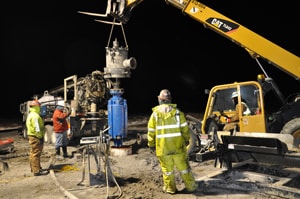Mining Feature: New Equipment and Protocol for Drilling Large-Diameter Rescue Boreholes
Tuesday, January 28, 2014
Late on a Tuesday night in October, 2010, more than 10 million people were watching CNN, Fox News, and MSNBC to witness live an unprecedented event—the rescue of 33 miners who had been trapped underground for two months in the San Jose Mine, Copiapo, Chile. Eight years before that, on a hot July weekend in Somerset, PA, viewers also watched through the middle of the night as 9 miners who had been trapped for more than 77 hours in the Quecreek Mine were hoisted to the surface, one by one, in a yellow steel capsule.
These two dramatic rescues had one important thing in common: They both relied on the drilling of a large-diameter borehole, which enabled the safe ascent of miners to the surface. However, the two rescues also shared a noteworthy challenge: The drilling could have begun earlier had the necessary equipment and expertise been more immediately available. These two stories underscore how critical it is for the mining industry to have specialized drilling equipment readily available in case of an emergency, and to have a defined protocol for mobilizing and using that equipment. A recently completed contract awarded by OMSHR resulted in a two-part package—specially fabricated drilling tools and a detailed protocol for drilling a rescue hole in an emergency—to ensure that mine operators can be even more prepared when rapid rescue drilling is needed. The contract work was performed by the company that supplied the equipment to help drill the rescue holes for both the Quecreek and San Jose Mines.
The new specialized drilling equipment is stored at the NIOSH Pittsburgh campus in Bruceton, PA. The equipment includes a 12-inch-diameter bit for drilling the initial pilot hole, a 28-inch-diameter bit capable of penetrating extremely hard rock and creating a hole large enough for a rescue capsule, and 200 feet of can-rods necessary for drilling such a large hole through the earth. The can-rods, 18 inches in diameter, help to maintain the desired physical relationship between the drill bit and the sides of the drill hole, allowing for rapid removal of the rock cuttings as the drilling progresses.
In addition, a protocol for drilling a rescue borehole has been established that can be integrated into a mine’s emergency response plan. The protocol includes a listing of over 60 drilling companies in the United States capable of utilizing the specialized drilling equipment, organized by region and with the names and phone numbers of contacts at these companies.
As this protocol was developed and the new drilling equipment was tested, OMSHR learned some important lessons about how drilling times can be influenced by abandoned or flooded mine workings between the surface and the rescue area (a flooded mine working is what led to the incident at the Quecreek Mine). Other lessons learned included the use of directional drilling to avoid large voids, openings, or highly fractured strata, the need for an ample supply of ancillary equipment such as a water truck, extra air compressors, and a high lift, and the necessity of creating a solid, well-constructed drilling platform from which to initiate rescue operations. The more effectively this protocol is put into place both before and during an emergency, the less likelihood that precious time will be wasted and the greater likelihood that the fewest number of boreholes can be drilled rapidly to reach trapped miners.
For further information about the availability of the drilling equipment and the protocol, please request a copy of the final report.
- Emergency Escape and Refuge Alternatives
- Emergency Response Planning for Small Mines: Who Needs It?
- Neural Network Technology for Strata Strength Characterization
- An Oral History Analysis of Mine Emergency Response
- Rapid Response Rescue Drilling System Development for Mine Rescue Application
- Research and Evaluation Methods For Measuring Nonroutine Mine Health and Safety Skills: Bibliography
- Technology News 447 - Dust Collector Discharge Shroud Reduces Dust Exposure to Drill Operators at Surface Coal Mines
- Training for Safety in Emergencies Inoculating for Underground Coal Mine Emergencies
- Using the Internet to Train Emergency Command Center Personnel
- Wearing Hearing Protection Properly: A 3-D Training Aid for Drillers
- When Do You Take Refuge? Decisionmaking During Mine Emergency Escape
